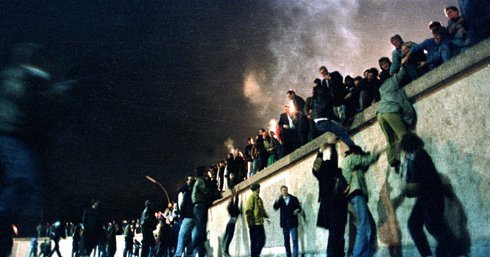While forming merry youthful bands, standing close to one another near a cardboard wall and idealistic signposts on a chilly 9th of November, JEF delegations across Europe were for one night united in minds, wishes, and perhaps also dreams. Remembering the 20th anniversary of the fall of the Berlin Wall, and similarly calling upon bystanders to consider that in current-day state policies some harsh visa policies still reign and prevent migrants and travelers from seeking experience, happiness, new friends, old acquaintances, work, and initiating projects elsewhere. Candles where lit to commemorate and inspire hope for a more open and tolerant society where all well-intending people, regardless of their origin or destination, are allowed to transit.
Remnants of the Iron curtain, reconstructed and re-enacted Checkpoint Charlie’s and ruined watch-towers are now icons of a not-so-far-gone history of the Cold War. The practice of ‘border control’ may have undergone major changes over the years, yet frisk searches and scans cause waiting lines and not too comfortable experiences for most (law-abiding) travelers. Even visa regimes have not been made obsolete amongst nations that proclaim themselves as great examples of democracy and liberty. Such standardized measures of protection in the name of national security are set in place to ‘serve and protect’.
The efficient balance is to be sought between the ‘lightweight’ and limited control and the bureaucratic, Kafkaesque national security state.
On second thought, in a federalist societal model visa regimes ought to be a thing of the past. Visa equals borders (not to mention financial indemnity and loss of time), although we understand the intent to keep a certain degree of oversight and tracking over flows of travelers entering, residing and leaving the EU zone. The efficient balance is to be sought between the ‘lightweight’ and limited control and the bureaucratic, Kafkaesque national security state. Without due process and firm consensus on maintaining standards for legitimated surveillance, a society is surrendered to the hands of a virtual ‘panopticon’ where a lot of activity and behaviour becomes scrutinized. Common sense vigilance is our best guide, not a psychosis of fear and black-white oppositions.
The management of civil migration flows ought not remain a matter of imposing deterrents (borders, checkpoints, visa’s, registration and criminal records checks, and even ‘counter-advisory policies’ in countries of origin), it also has to be analyzed and influenced based on the long-term resilience of the social security structures, the quality of the school systems (supposing migrants also think about the quality of study of their children in longer perspective), employment opportunities and the evolving housing market. We cannot desire ghettoization, clustering or a continued expansion of huge, asocial apartment complexes overtaking the urban landscape.
Germans from both sides have been able to cross the once strictly separated map for twenty years now. After the Wall split public life in Germany and abroad, inhabitants of West-Berlin were forced to live in a physical enclave for twenty-eight years, a sole spark of Western democracy in the Soviet occupied zone. But while the installation of the Berlin wall was a rushed and relatively unprepared enterprise (one ought to know, it was a single Stasi officer in the DDR office of urban planning who was ordered to establish a painted line through the city street grid, a track onto which the wall would be erected), the fall of this architectural behemoth was the result of a turnaround which was long in the making, but nevertheless proved a decisive milestone that appeared to many as an unexpected, miraculous, life-changing event.
Its heroic, spectacular and ear-deafening downfall may have occurred in just a few hours, the long path to severing the barrier was preceded by a social, organic process of ‘quieter’ revolt. The main forces undermining the highly self-conscious DDR regime, were the very burdensome human, social and economical circumstances and pressures, embedded in this long-term socialist experiment.
Western perceptions aside, we ought to refrain slightly from the generalized idea that East Germans where ‘locked up’ inside this system from the start at the time the wall was built. It is estimated that already 3,5 million East Germans fled to West Germany before 1961. Many more afterwards tried to flee to the West, with personal risk of life as soon as the first barbed wire fences and armed guards were put in place as a first deterrent line. When a new passport law was imposed, more and more people started fleeing through West Berlin (over 90 percent in 1958).
Perhaps the most frantic, near-surreal record of the early stages of Berlin’s apartheid is that of an elderly woman, trying to escape downwards from an open window on the third floor, and her body is being pulled defiantly by DDR fanatics there, trying to reel her back in, while others on the floor below her are trying to get her safely down, so she could flee to the capitalist West. For the rest, the opposition between the blocs happened in a horizontal direction, as far as we know. Yet she was the first real victim of the Berlin Wall: she passed away in a hospital only days her attempt to cross sides and enter the BRD ‘one floor down’. Her hearth collapsed over the horrifying torment, halfway two floors, between a regime of rigid uniformity and the Western sphere promising liberal markets and capitalist-minded personal autonomy. A tragic episode that occurred a while before the ditches, the death strip, and watchtowers and patrol guards were set in place for almost three decades.
The socialist human kind, so it was portrayed, would soon be living in a German Democratic Republic, a state form that showed a certain attractiveness and potential, but enclosed a society that, over time, could no longer bear the ardent ideological straitjacket. Or should one say: the DDR state categorized and chose its people, and made them extraordinary by consolidating ideological homogeneity. Its inhabitants had to become the loyal adherents of this ideology, and were convinced or coerced to be part of it. The DDR state model designed its population, the ideal task of the public mass, from its own ranks, the population was not at liberty to commonly draw up the model of their state. The DDR boasted pride over this new industrious, bright ‘socialist citizen’. At least, the ideology was by far incomparable to fascism. Only solidarity was framed in a different (but nonetheless similarly exclusive) context. But individualism, mobility, interactivity, liberty, and self-expression without state-imposed social norms and rules prevailed after twenty years of a tried mass social state experiment. Even though everyone in the DDR enjoyed secure and guaranteed employment (yet excluded more opportunities for private entrepreneurship), an objective that to this day cannot be (unless by force) achieved in a free society that prefers the liberal market of employment.
Twenty years from now, will we be living in a Europe that embraces its ‘neighborhood’ and let go of administrative constraints to travel and family reunion? Not a fortress, nor a torn-apart ‘migration sponge’. But a better and federal Europe that does not deny or infringe upon one’s rightful opportunities as citizens, employees, students and pupils, fathers and mothers, sons and daughters. May we never be split nor blinded by opposed blocs or societal divide again in such a profound and radical sense, as we were once 20 years ago.


Follow the comments: |
|
